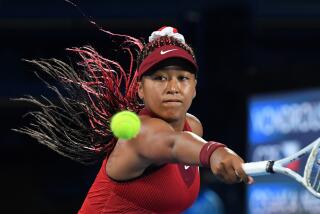A SCORE TO SETTLE : Bhushan, a South Korean Native, Hopes to Turn Tables in Seoul
- Share via
To become a world-class table tennis player in this country is to assume a protective identity. Nobody will ever find you, at least not here. Yet try to walk the streets of China. Henan Li Ai, the U.S. team’s coach, returned to Beijing last month and was, according to a team sponsor along for the ride, accorded the celebrity of Reggie Jackson.
The only difference was that Henan Li Ai has been retired for 20 years and has been away from her homeland about that long.
This is another of those sports; it is to Asia what soccer is to Europe. It’s little known and less appreciated here, yet it is played and followed with an insane fervor internationally.
Take Insook Bhushan, who not only is this country’s best female player, but this hemisphere’s best. You’ve probably never heard of her. Yet, Bhushan, 36, is one of just two U.S. athletes returning home for the Seoul Games, and thus is one of the Olympics’ more interesting stories.
Bhushan, who followed her parents to New York in 1974, is not simply returning to Seoul, but returning with a vengeance. Now a Denver homemaker and mother, she will show up in Seoul transformed by thoughts of retribution, wreathed in an old fame, an Olympic warrior.
She was one of Korea’s best once, a long time ago. And they more or less retired her at 21. Table tennis stars--this is not Ping Pong--have a short shelf life, true. But she wasn’t quite ready to go.
It’s funny how an entire ocean, what separates Bhushan from her homeland, can’t dampen her smoldering fury. Nor can iears of domesticity. Although she is mild-mannered, her anger and hurt still rise to the surface when the talk turns to South Korea.
It seems that the South Koreans really botched the team selection for the World Championships back in 1973. The team coach, who happened to be Bhushan’s personal coach, was under the impression that he could take five women, instead of the usual four. He was wrong.
So he was forced to subtract one of the team members. Apparently embarrassed at blowing the rule, he chose to attract as little attention to himself as possible by removing his own player. At least none of the other coaches would point fingers. Bhushan was gone.
“I was not the fifth girl,” Bhushan says steadily. “I was third. I still remember every time I think about it. Not a pleasant thing. Not a pleasant thing to remember.”
Bob Tretheway, national program director of the U.S. Table Tennis Assn., figures, “Here you have a young girl playing since the age of 12, with one goal, making the World Championship team. And zap! I don’t think she was too fond of the way things were handled. She may have a point to prove.”
It is not likely that Bhushan will get to prove it all that dramatically. Because of her age, her style and her lack of recent international experience--she must train here in the United States, where there aren’t any world-class partners--she is not much of a contender. She won four gold medals in the Pan American games in 1983 without losing a game, much less a match. In 1987, she won three Pan American golds, dropping all of two games. Yet she is ranked just 67th in the world.
Bhushan has no illusions of doing an “I told you so” in Seoul. She, like no one in this country, knows what it takes to be a top table tennis player. She once was one. A mother of two taking accounting classes at the University of Colorado can hardly do it again.
As it is, she strikes Tretheway as being a training maniac. “I saw her finish a three-hour practice session the other day and then she went out and put three miles on the track,” he said. “I wanted to say, ‘Hey, Insook, relax.’ ”
But the Koreans, who treat this as a national sport, not a basement recreation, are doing more, and Bhushan knows it. Even though she commutes from Denver to Colorado Springs five times a week, it is not the same, she said. “They are training longer and harder.”
And, of course, they are younger. When the U.S. team went to China to train for seven weeks, the other players were agog at her age. Table tennis players are much like female gymnasts, used up by their teens.
“When they found out I was 36, their mouths dropped open,” she said. Even when she was playing at 21, she added, she was considered “an old lady.”
Perhaps the fact that she plays at all, never mind in Seoul, is what’s so amazing about her. After all, she never meant to play again after immigrating to the United States. The only reason she did was out of boredom.
“I had to learn English,” she said. “When I first came, I only spoke broken English. I couldn’t go to school right away, so I was bored. I couldn’t do anything else, so when I heard about this tournament in Columbus, Ohio, I said, ‘Why not?’ I played and met lots of people. I was not only beating the women, but also the men. People wanted to talk to me; they had many questions. It worked out OK because I learned English.”
She stayed with her old sport, but not out of competitive desire. “It was more social,” she said.
Still, she was soon lured back onto the world stage, and she even traveled to North Korea in 1979. Looking back, she believes that was naive.
“The North Koreans don’t like South Koreans and they don’t like Americans,” she said. “I was a double enemy. There were 20,000 people there (at the World Championships) and every time I played, they were cheering against me. They kept staring at me, all the time watching me, and not with a smile. Just looking at me.”
Although she expects a kinder reception in Seoul, “where they will know me, probably,” she is still not all that eager about the homecoming. “I wish it were somewhere else,” she said, as her heart is no longer where her homeland is.
However, the truth of the matter is that if South Korea were not the Olympic host, table tennis would not have been introduced as a full medal Olympic sport.
Bhushan will have her hands full in the sport’s Olympic debut. She’s considered a chopper, an underspin artist who wears opponents down with defensive play. That style was popular in the ‘50s and ‘60s but has since given way to the blast-away table tennis--forehand counter-drivers, they’re called--you now see, with players standing 15 feet from the table. Because Bhushan’s style is now unique, many other players have trouble with it.
Yet in China, the teams employ underspinners just as practice partners, in case anyone ever should run into an Insook Bhushan. The surprise advantage she enjoys over the Europeans will be not be so evident at the Olympics.
Still, the story of Insook Bhushan is not whether she will win, but that she will compete, and with an intensity undiminished by years and a change of nationality.
More to Read
Go beyond the scoreboard
Get the latest on L.A.'s teams in the daily Sports Report newsletter.
You may occasionally receive promotional content from the Los Angeles Times.






